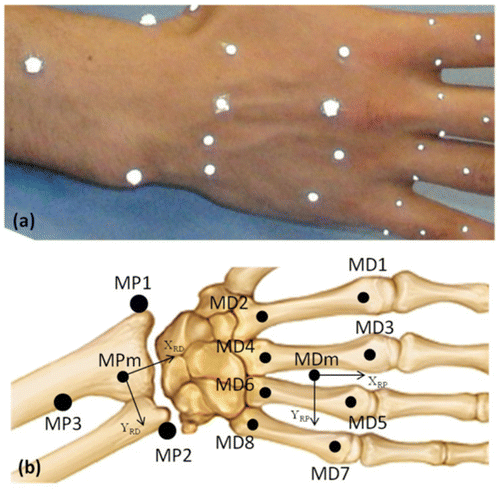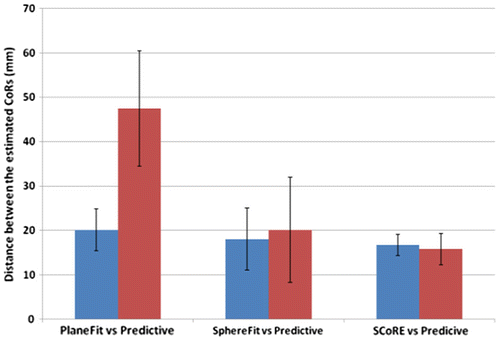1. Introduction
The human hand is involved in many daily human activities. The hand is connected to the forearm by the wrist joint which contributes to its special orientation facilitating the manipulation of objects (Hansen et al. Citation2017). However, the wrist joint has a complex organisation of carpal bones. Consequently, when describing wrist joint kinematics, an accurate kinematic model is necessary. The traditional approach for modelling the wrist joint is to consider it as a revolute joint (Vignais et al. 2014), hence requiring the localisation of the center of rotation of this joint. The aim of this paper is to compare three functional and one predictive method to estimate the center of rotation (CoR) of the wrist joint.
2. Methods
Nine healthy subjects (age: 31.67 ± 9.07years, bodyweight: 72.33 ± 13.65kg, height: 175.33 ± 11.06cm) participated in the experiment. Subjects were asked to do three repetitions of flexion-extension (F-E) and abduction-adduction (A-A) movements of the wrist joint.
Eight 3-mm diameter markers were fixed on the skin above the metacarpal segment of the hand. Two 5-mm diameter markers were fixed on the ulnar and radial styloid processes, and one 5-mm diameter marker was fixed on the posterior face of the forearm. Data were collected using a motion capture system (17 cameras T160, Vicon, Oxford Metrics Ltd, Oxford, UK). Data analysis was performed using MATLAB 7.6 (Mathworks, Inc.; Natick, MA). Three repetitions in F-E and A-A were performed by the subjects during the motion capture.
Three functional methods and one predictive method were used to estimate the joint CoR. In the Plane-Fitting (PF) method, marker trajectories of the distal segment are assumed to be planar and circular. Least square planes and least square circles are calculated from the markers trajectories. In the Sphere-Fitting (SP) method, movements of markers in the distal segment are assumed to belong to spherical surfaces. A least square sphere is calculated from these trajectories (Devos et al. Citation2014). The symmetrical CoR estimation (SCoRE) is another functional method (Ehrig et al. Citation2006) to estimate the CoR. A predictive method was also used in this study to estimate the CoR as the mean point between the markers fixed on the ulnar and the radial styloid processes (Schmidt et al Citation1999).
3. Results and discussion
The mean distances between the CoRs computed from the functional methods and the CoR calculated from the predictive method (figure ) ranged from 11 mm (SphereFit vs Predictive) to 25 mm (PlaneFit vs Predictive) in F-E.
Figure 1 (a) Location of skin-fixed markers on the dorsal face of the wrist joint. (b) Computation of the coordinate systems located from marker locations in the proximal and the distal segments.

Figure 2 Mean distances (mm) and the ranges of CoRs estimated from the functional methods and range of the CoR estimated from the predictive method in F-E (blue) and in A-A (red).

In A-A, these results ranged from 14 mm (SCoRE vs Predictive) to 61 mm (PlaneFit vs Predictive) in A-A. These results suggest that CoRs computed with the SCoRE method are closer to the CoR computed with the predictive method.
However, the Plane-Fitting method seems to be inappropriate for estimating the CoR of the wrist joint in the case of the A-A movement.
The Root Mean Square (RMS) computed in the case of F-E movement ranged from 0.03 mm (RMS plane fitting) to 0.8 mm (RMS circle fitting). In the case of A-A movement, the RMS ranged from 0.02 mm (RMS plane fitting) to 4.5 mm (RMS circle fitting).
As suggested in Gamage and Lasenby (Gamage and Lasenby, Citation2002), we used several markers per segment in order to provide redundant information for the estimation of the joint’s CoR. However, skin movement artefacts (Cappozzo et al, Citation1996) are responsible for marker movement relative to the underlying bone during motion. They may influence the estimation of the CoR between the different functional methods.
F-E and A-A movements can be considered as planar movements. However, the results of the mean distances show that the A-A movement cannot simply be considered as a circular movement, but rather as a combination of movements. Other least squares methods can be found in the literature to estimate the CoR of the human hand (Ehrig et al, Citation2006).
RMS computed from the least square circles in F-E and in A-A suggest that these movements cannot be considered as circular. The motion of the wrist joint may not be able to be assimilated to a pure F-E or a A-A movement, also they should rather be considered as a combination of movements for the estimation of the joint’s CoR (Chang et al. 2007).
The limitation of our study was to consider the predictive method as the reference which could be questionable.
4. Conclusions
The aim of this study was to compare the CoRs computed from three different functional methods to the CoR computed from a predictive method to find the most appropriate method to estimate the wrist joint CoR. Another aim of this study was to compute the RMS of the Plane-Fitting and the Sphere-Fitting methods in order to assume the F-E or the A-A movement as a planar or a spherical movement.
Despite demonstrating that the F-E and the A-A movements of the wrist joint can be assumed as quasi-planar movements, the A-A movement cannot be considered as a circular movement. Further studies would be necessary to identify the different components of the A-A movement.
Acknowledgements
Project MANDARIN (ANR 2012 – CORD01103) and the Picardie Region (N°1,212,002,746).
References
- Cappozzo A, Catani F, Leardini A, Benedetti MG, Della Croce U. 1996. Position and orientation in space of bones during movement: experimental artefacts. Clin Biomech. 11(2):90–100.10.1016/0268-0033(95)00046-1
- Chang LY, Pollard NS. 2007. Robust estimation of dominant axis of rotation. J Biomech. 40(12):2707–2715.10.1016/j.jbiomech.2007.01.010
- Devos P, Ben Mansour K, Hansen C, Marin F. 2014. Estimation of the fingers joint axes of rotation in flexion–extension. Computer Methods in Biomechanics and Biomedical Engineering. 17(sup1):96–97.10.1080/10255842.2014.931162
- Ehrig RM, Taylor WR, Duda GN, Heller MO. 2006. A survey of formal methods for determining the centre of rotation of ball joints. J Biomech. 39(15):2798–2809.10.1016/j.jbiomech.2005.10.002
- Gamage SS, Lasenby J. 2002. New least squares solutions for estimating the average centre of rotation and the axis of rotation. J Biomech. 35(1):87–93.10.1016/S0021-9290(01)00160-9
- Hansen C, Arambel P, Ben Mansour K, Perdereau V, Marin F. 2017. Human-Human Handover Tasks and How Distance and Object Mass Matter. Perceptual and Motor Skills. 124(1):182–199.10.1177/0031512516682668
- Schmidt R, Disselhorst-Klug C, Silny J, Rau G. 1999. A marker-based measurement procedure for unconstrained wrist and elbow motions. J Biomech. 32(6):615–621.10.1016/S0021-9290(99)00036-6
- Vignais N, Marin F. 2014. Analysis of the musculoskeletal system of the hand and forearm during a cylinder grasping task. International Journal of Industrial Ergonomics. 44(4):535–543.10.1016/j.ergon.2014.03.006
